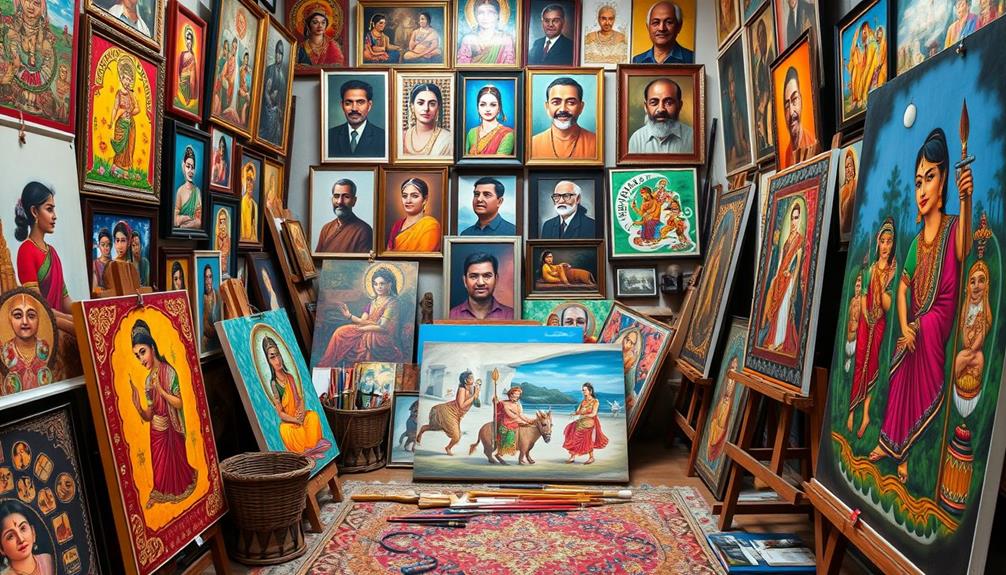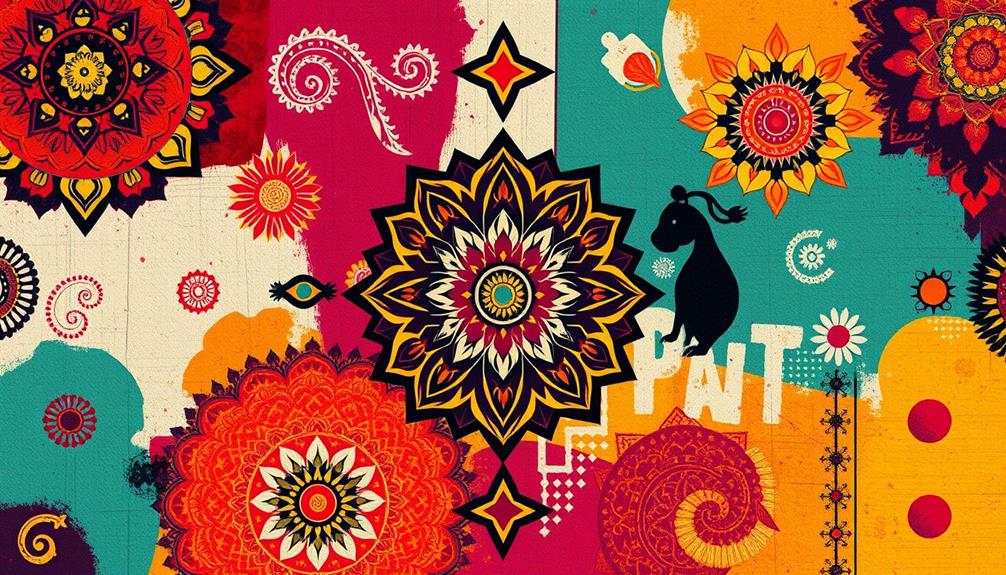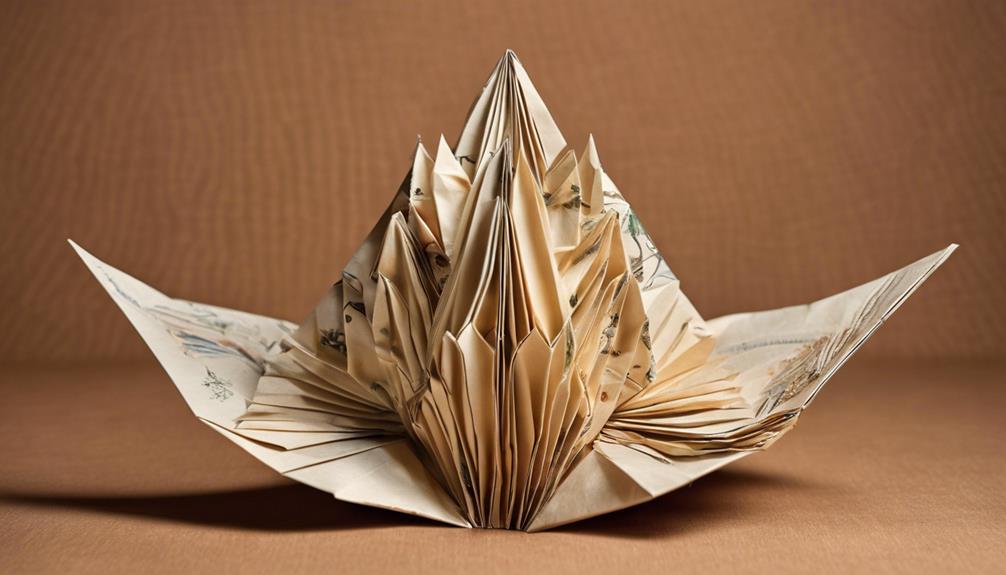When you explore the Bengal School of Art, you uncover a vibrant movement rooted in India's struggle for national identity. Founded by figures like Abanindranath Tagore, the school celebrated indigenous themes through rich techniques inspired by Mughal and Rajput art. Artists like Nandalal Bose and Gaganendranath Tagore contributed to the legacy by merging traditional and modern styles. The impact of their work continues to resonate in contemporary art, inspiring new generations. This revival of interest signals an exciting journey into India's rich cultural narrative, inviting you to discover even more about its artistic heritage.
Key Takeaways
- The Bengal School of Art emerged in the late 19th century, aiming to revive traditional Indian art and assert cultural identity against colonial influence.
- Key figures include Abanindranath Tagore, Nandalal Bose, and Gaganendranath Tagore, who celebrated indigenous themes and techniques in their works.
- The movement emphasized the use of indigenous materials and techniques, showcasing vibrant colors and drawing inspiration from Indian mythology and folklore.
- Its cultural impact reshaped Indian identity and nationalism, influencing contemporary artists and art education through institutions like Kala Bhavan.
- The legacy of the Bengal School continues to inspire modern interpretations of tradition, blending historical themes with contemporary artistic practices.
Overview of the Bengal School
The Bengal School of Art emerged in the late 19th century as a vibrant response to British colonial rule, aiming to revive traditional Indian art forms. This movement wasn't just about art; it was deeply intertwined with Indian nationalism and a desire to assert cultural identity.
Bengal School artists like Abanindranath Tagore and Nandalal Bose focused on indigenous themes, creating works that celebrated India's rich heritage. Their work reflects a growing awareness of the importance of cultural expression, similar to how astrology claims to influence personality traits linked to attractiveness.
They drew inspiration from Mughal miniatures and Rajput paintings, merging these influences with Western artistic techniques. This blend resulted in unique compositions characterized by vibrant color palettes and emotive storytelling.
The Bengal School sought to break away from the confines of colonial art, emphasizing the importance of traditional Indian art and its techniques.
Key Figures and Artists
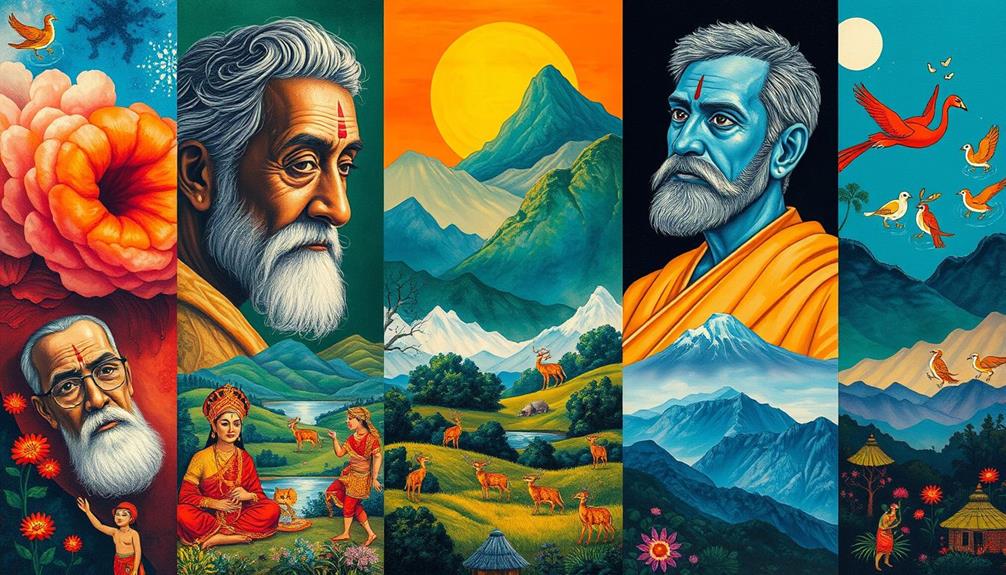
Several key figures played crucial roles in shaping the Bengal School of Art, each contributing unique perspectives and talents. At the forefront is Abanindranath Tagore, the founder, whose iconic painting "Bharat Mata" embodies national aspirations and emphasizes Indian artistic traditions. His vision laid the groundwork for a revival of Indian art.
| Artist | Contribution |
|---|---|
| Abanindranath Tagore | Founded the Bengal School; created "Bharat Mata" |
| Nandalal Bose | Developed nationalistic themes; Haripura Posters in 1938 |
| Gaganendranath Tagore | Merged traditional art with modernism; explored abstraction |
| Asit Kumar Haldar | Inspired by Buddhist art; depicted Indian epics lyrically |
E.B. Havell, a key promoter of the movement, advocated for Mughal miniature techniques and greatly influenced art education in India. His efforts helped establish a cohesive identity for the Bengal School, intertwining national identity with artistic expression. Through the contributions of these artists, the Bengal School became a crucial force in redefining Indian art, fostering a deep connection to its cultural roots while embracing innovation.
Artistic Techniques and Themes
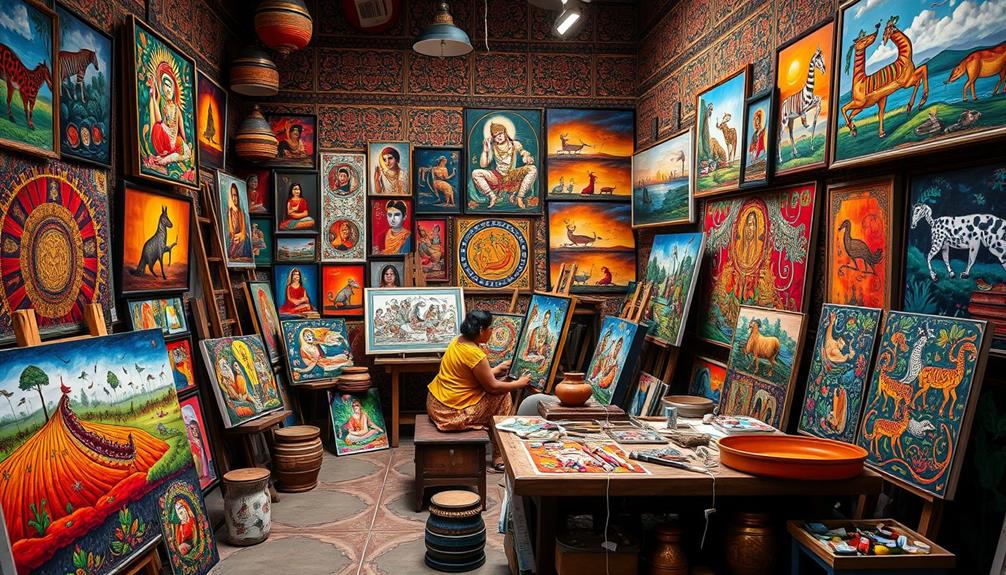
Often, the Bengal School of Art showcases a fascinating blend of traditional techniques and themes deeply rooted in Indian culture. You'll notice how artists employed indigenous materials like tempera, using vibrant colors to create works that emphasize simplicity and elegance. This movement frequently draws inspiration from Indian mythology and folklore, reflecting national pride and cultural identity. A perfect example is Abanindranath Tagore's "Bharat Mata," which beautifully encapsulates these themes.
The approach to creativity in this art form can also be likened to the principles of the energy flow and blockages which emphasize the importance of maintaining clear pathways for expression and liveliness.
The artistic techniques in the Bengal School often feature influences from Japanese wash methods, allowing artists to merge flat two-dimensional styles with intricate detailing. This departure from Western conventions focuses instead on traditional aesthetics, highlighted in serene figures found in Nandalal Bose's untitled works.
You'll also find signature styles characterized by thick contour lines and flat applications, which became hallmarks of the Bengal School. Jamini Roy's portrayal of Bengali women exemplifies modern expressions while maintaining a connection to cultural roots.
Ultimately, the artistic techniques and themes within the Bengal School of Art serve as a celebration of India's rich heritage, inviting viewers to explore its depths and nuances.
Cultural Impact and Legacy
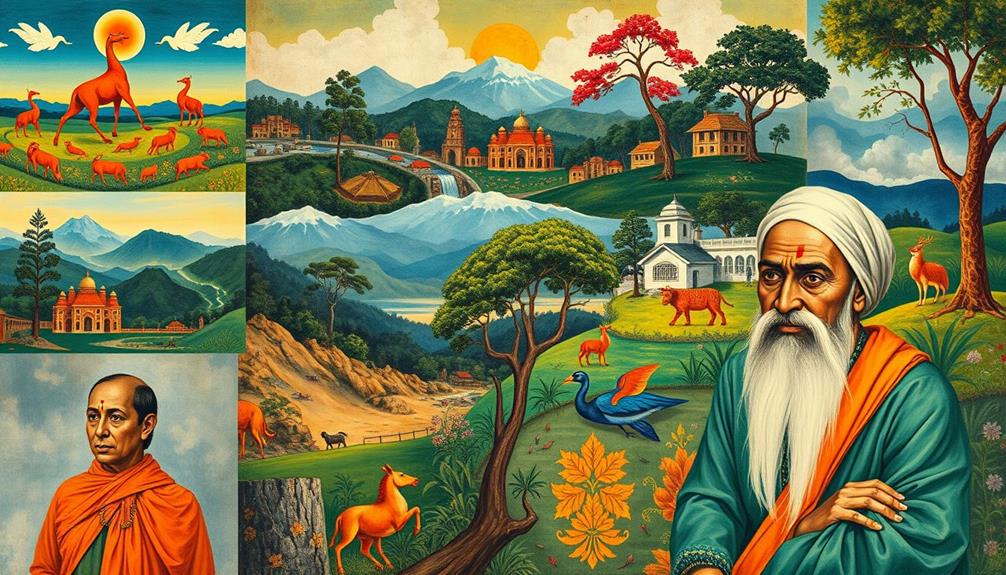
Cultural impact and legacy of the Bengal School of Art are immense, reshaping how Indian identity and nationalism are expressed through visual creativity. By incorporating indigenous themes and traditional art techniques, this movement played a vital role during the Indian independence movement.
Artists like Abanindranath Tagore and Nandalal Bose not only inspired a new generation of artists but also established institutions like Kala Bhavan at Santiniketan, which continue to promote modern farmhouse decor trends alongside traditional practices and modernist ideas. These institutions continue to promote both traditional practices and modernist ideas.
The Bengal School's emphasis on spirituality and mythology has greatly enriched the cultural landscape of Indian art. It fosters a sense of pride in cultural history that resonates deeply with audiences today. You can see this revival of interest in traditional Indian art forms, as contemporary artists explore their heritage and identity in diverse ways.
Additionally, recognition of Bengal School artists in national and international exhibitions has solidified their impact on the global art scene.
Ultimately, the legacy of the Bengal School of Art guarantees that its contributions to the evolution of Indian art are celebrated and studied, leaving an indelible mark on how you perceive and appreciate Indian creativity today.
Notable Works and Contributions
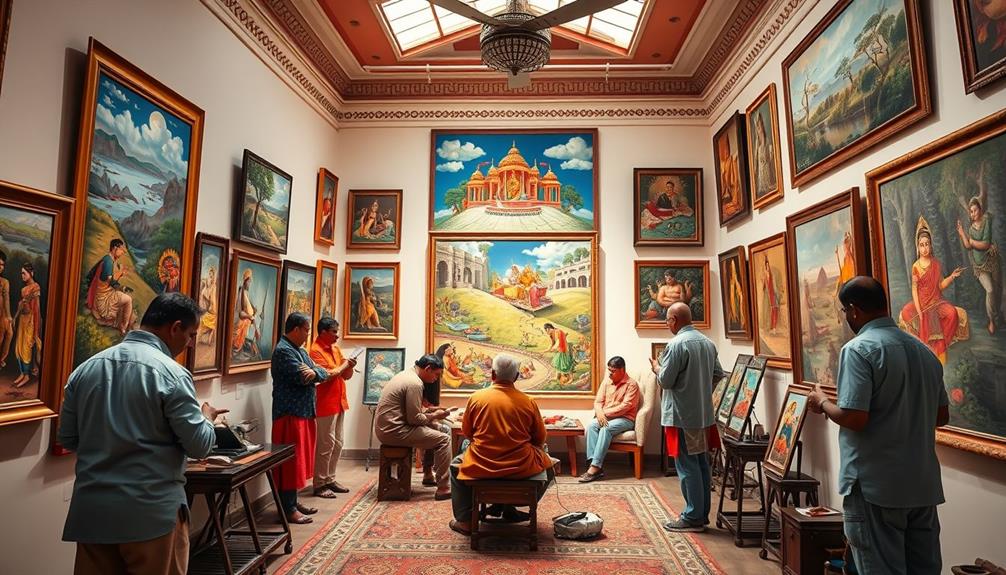
The Bengal School of Art boasts a remarkable collection of notable works that encapsulate its significance in Indian art history. Abanindranath Tagore's iconic painting "Bharat Mata," created in 1905, stands as a powerful symbol of Indian nationalism and spirituality, establishing him as a pivotal figure in the Bengal School.
This artistic movement, much like the contemporary art trends emerging today, reflects a deep engagement with cultural identity and social issues. Nandalal Bose's "Haripura Posters" further promoted Indian culture and nationalism, playing an essential role during the Indian independence movement.
In the domain of modernist expressions, Gaganendranath Tagore's "Chaitanya With His Followers" showcases an innovative blend of traditional themes with Cubist influences.
You'll find Asit Kumar Haldar's "Yashoda & Krishna" particularly enchanting, as it reflects a deep connection to Indian mythology while capturing the lyrical elegance of rural life. Additionally, M.A.R. Chughtai's "Mumtaz Mahal" highlights his unique style, combining Mughal influences with a contemporary perspective.
These works not only demonstrate the artistic prowess of their creators but also solidify the Bengal School's legacy in shaping the narrative of Indian art, emphasizing nationalism and the rich cultural tapestry of the region.
Contemporary Relevance and Influence
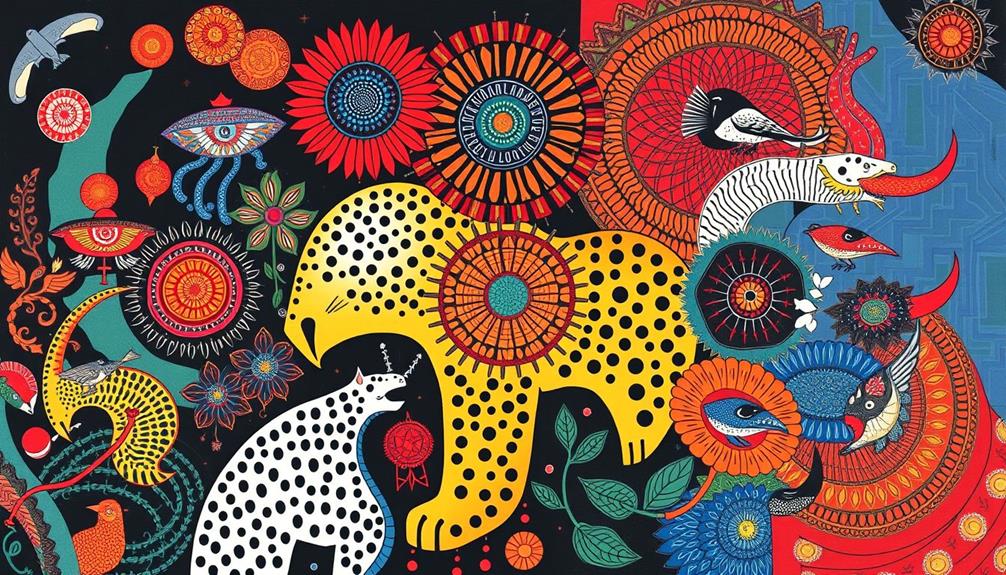
The Bengal School of Art has left a lasting mark on today's artists, inspiring you to blend traditional themes with modern techniques.
As you explore contemporary interpretations, you'll see how artists are redefining cultural heritage while educational institutions like Santiniketan nurture this creative evolution.
This fusion not only honors the past but also enriches the current art scene, making cultural preservation more crucial than ever.
Additionally, just as artists draw from rich histories, many are also turning to natural wellness practices, such as essential oils for relaxation, to enhance their creative processes and mental clarity.
This holistic approach highlights the interconnectedness of artistic expression and personal well-being.
Lasting Artistic Influence
Bengal School of Art continues to resonate deeply within contemporary artistic practices, inspiring a new generation of artists. This influence can be seen as a counter to the pervasive narcissistic tendencies often found in modern society, as artists draw from community and cultural narratives rather than individualism.
You'll find this influence manifesting in various ways, with contemporary artists like Jogen Chowdhury and Ganesh Pyne seamlessly blending traditional aesthetics into their modern works. This movement has laid a strong foundation for the evolution of Modern Art in India, intertwining cultural heritage with national identity.
Here are four key aspects of the Bengal School's lasting impact:
- Revival of Traditional Techniques: The emphasis on indigenous themes has rejuvenated interest in traditional art practices.
- Artistic Education: Institutions like Kala Bhavan at Santiniketan promote artistic education that fosters exploration of cultural heritage.
- Cultural Identity: The Bengal School's focus on spirituality and national identity continues to resonate within contemporary exhibitions.
- Global Recognition: Since 2012, there's been a resurgence of interest in Bengal School artists worldwide, affirming their relevance in global art circles.
These elements underscore how the Bengal School of Art remains a cornerstone for contemporary artists, shaping both their work and the broader artistic landscape.
Modern Interpretations of Tradition
Modern interpretations of tradition in the Bengal School of Art showcase how historical themes can be reimagined to resonate with today's audiences. Contemporary artists like Jogen Chowdhury and Ganesh Pyne draw heavily from the Bengal School, weaving Indian mythology and folklore into their works. This approach not only honors the legacy of the Bengal School but also reflects a modern understanding of cultural identity and nationalism.
| Aspect | Influence on Contemporary Art |
|---|---|
| Themes | Reimagining Indian mythology in new contexts |
| Techniques | Use of indigenous materials and traditional methods |
| Legacy in Education | Institutions like Kala Bhavan uphold these traditions |
These modern interpretations highlight how the Bengal School's emphasis on cultural roots remains relevant in today's globalized art scene. Art historians and critics are increasingly engaging in discussions about its role in shaping modern Indian art and identity, especially within the framework of post-colonialism. Through exhibitions and contemporary practices, the rich legacy of the Bengal School continues to inspire and influence the evolving narrative of Indian art.
Educational Impact on Art
Often regarded as a pivotal movement in Indian art education, the Bengal School of Art has left a lasting impact that resonates in contemporary practices. Its legacy continues to shape how you approach art education and artistic expression today.
Here are some key influences:
- Emphasis on Indigenous Techniques: Key figures like Abanindranath Tagore and Nandalal Bose prioritized indigenous techniques, enriching the curriculum with traditional art forms. The focus on incorporating local artistic methods mirrors modern trends in sustainable home decor, where eco-friendly materials are celebrated for their cultural significance sustainable home decor.
- Cultural Heritage Integration: The blending of traditional Indian aesthetics with modern sensibilities encourages contemporary art programs to incorporate diverse regional styles.
- Nationalism in Art: The movement's discourse around nationalism in art remains relevant, influencing critiques and themes in today's artistic landscape.
- Revival of Art History: A resurgence of interest in Indian art history has led to academic courses exploring the Bengal School's impact on modern artistic practices and identity formation.
Frequently Asked Questions
Who Were the Main Artist Behind the Bengal School?
The main artists behind the Bengal School are Abanindranath Tagore, Nandalal Bose, Gaganendranath Tagore, Asit Kumar Haldar, and E.B. Havell. Each contributed uniquely, blending traditional techniques with modern themes to shape Indian art's identity.
Which Two Main Persons Were Responsible for Bringing Bengal School of Art in India?
Imagine two gardeners, Abanindranath Tagore and Nandalal Bose, nurturing India's artistic soil. You'll find they cultivated the Bengal School of Art, intertwining traditional themes and modern techniques, blossoming into a vibrant cultural movement.
What Are the Themes of the Bengal School of Art?
When you look at the Bengal School of Art, you'll notice themes like Indian mythology, rural life, and spiritual depth. Artists express national pride and cultural identity, often resisting colonial influences with vibrant, traditional aesthetics.
What Was the Role of Rabindranath Tagore in the Bengal School of Art?
Rabindranath Tagore played an essential role in the Bengal School of Art by promoting traditional Indian aesthetics, inspiring you to explore indigenous themes, and integrating art with life through his creative works and educational initiatives.
Conclusion
As you reflect on the Bengal School of Art, you can't help but see its brushstrokes echoing through time, much like a whispered secret between generations. The legacy of its key figures continues to inspire today's artists, reminding you that creativity knows no boundaries. Just as Tagore's verses captured the essence of Bengal, the vibrant artwork invites you to explore identity, culture, and beauty in every piece. Embrace this rich heritage, and let it spark your own artistic journey.
